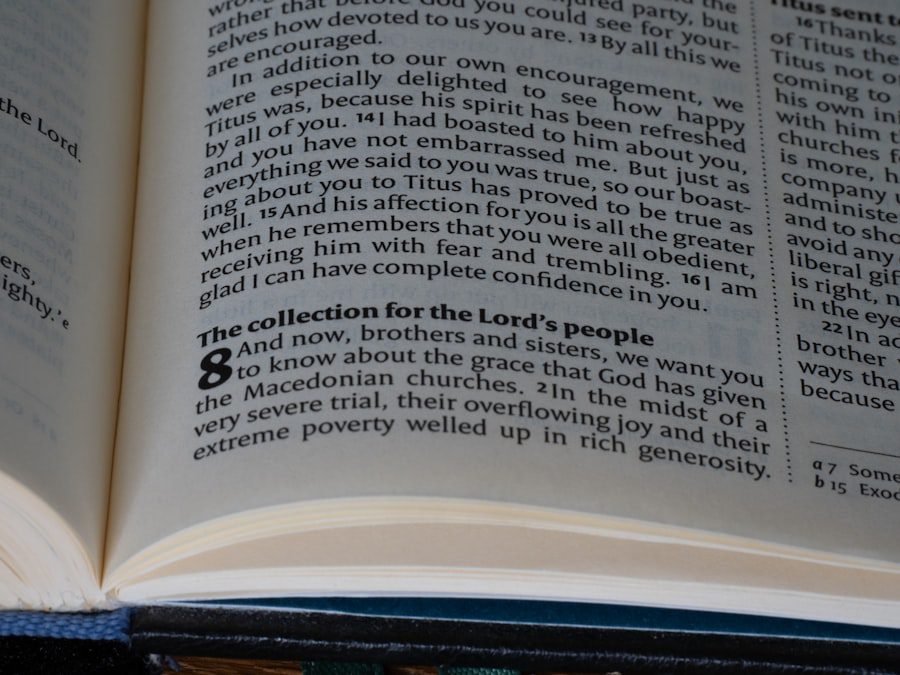Faith has long been recognized as a potent force in the realm of healing, transcending mere belief to become a transformative experience for many individuals. It is not uncommon to hear stories of people who have faced dire medical diagnoses, only to find solace and strength through their faith. This phenomenon can be attributed to the psychological and physiological effects that faith can have on the human body.
When individuals place their trust in a higher power or a greater purpose, they often experience a sense of peace that can alleviate stress and anxiety, which are known to hinder the healing process. The act of surrendering one’s fears and uncertainties can lead to a more positive outlook, which is crucial for recovery. Moreover, faith can foster a sense of community and support, which is essential during times of illness.
Many religious traditions emphasize the importance of communal prayer and support, creating an environment where individuals feel uplifted and encouraged. This collective energy can amplify the healing process, as shared beliefs and prayers can create a powerful synergy that enhances individual resilience. For instance, studies have shown that patients who engage in prayer or meditation often report lower levels of pain and anxiety, suggesting that faith not only provides emotional comfort but may also have tangible effects on physical health.
Key Takeaways
- Faith plays a significant role in the healing process, providing strength and resilience in the face of adversity.
- Finding hope in the midst of suffering is essential for maintaining a positive outlook and overcoming challenges.
- Love has the transformative power to heal, offering comfort and support during difficult times.
- The Gospel serves as a source of healing, providing guidance and solace to those in need.
- Overcoming challenges through faith requires a strong belief in the power of positivity and perseverance.
Finding Hope in the Midst of Suffering
Suffering is an inevitable part of the human experience, yet it is often through suffering that individuals discover profound hope. The journey through pain can lead to a deeper understanding of oneself and one’s place in the world. In many cases, suffering acts as a catalyst for personal growth, prompting individuals to reevaluate their priorities and beliefs.
This process can unveil new perspectives that foster hope, allowing individuals to envision a future beyond their current struggles. For example, those who have faced chronic illness often report that their experiences have led them to appreciate life more fully, cultivating a sense of gratitude that fuels their hope for recovery. In addition to personal transformation, hope can also emerge from the stories of others who have triumphed over adversity.
Hearing accounts of resilience can inspire individuals to persevere through their own challenges. This phenomenon is evident in support groups where members share their journeys, offering encouragement and motivation to one another. The act of witnessing another’s triumph can ignite a spark of hope within, reminding individuals that healing is possible even in the darkest of times.
This shared experience creates a tapestry of hope that binds individuals together, reinforcing the idea that they are not alone in their suffering.
The Transformative Power of Love in Healing

Love is often heralded as one of the most powerful forces in the universe, capable of fostering healing on multiple levels. The presence of love—whether from family, friends, or even pets—can significantly impact an individual’s emotional and physical well-being. Research has shown that loving relationships can lead to lower levels of stress hormones, improved immune function, and even enhanced recovery rates from illness.
The warmth and support derived from love create an environment conducive to healing, allowing individuals to feel safe and valued during their most vulnerable moments. Furthermore, love can manifest in various forms, each contributing uniquely to the healing process. Acts of kindness, compassion, and empathy can uplift those who are suffering, providing them with a sense of belonging and connection.
For instance, caregivers who approach their roles with love and compassion often create a nurturing atmosphere that promotes healing. This dynamic is particularly evident in palliative care settings, where the focus on holistic well-being—addressing not just physical symptoms but also emotional and spiritual needs—can lead to improved quality of life for patients facing terminal illnesses. The transformative power of love extends beyond mere emotional support; it becomes a vital component of comprehensive healing.
The Role of the Gospel in Bringing Healing
| Aspect | Impact |
|---|---|
| Physical Healing | Brings about miraculous healings and restoration of health |
| Emotional Healing | Provides comfort, peace, and hope in times of distress |
| Relational Healing | Restores broken relationships and promotes forgiveness |
| Spiritual Healing | Offers salvation, redemption, and eternal life |
The Gospel serves as a profound source of healing for countless individuals around the world. Its teachings emphasize themes of love, forgiveness, and redemption, which resonate deeply with those seeking solace in times of distress. Many find comfort in the narratives of Jesus’ healing miracles, which illustrate the belief that divine intervention is possible even in seemingly hopeless situations.
These stories inspire faith and encourage individuals to seek spiritual healing alongside physical recovery. The Gospel’s message reinforces the idea that suffering is not without purpose; rather, it can lead to spiritual growth and a closer relationship with God. Moreover, the Gospel encourages believers to extend love and compassion to others, creating a ripple effect that fosters community healing.
Churches often serve as sanctuaries for those in need, providing not only spiritual guidance but also practical support through outreach programs and counseling services. This communal aspect of faith can be particularly powerful in promoting healing, as individuals come together to share their burdens and uplift one another. The Gospel’s emphasis on forgiveness also plays a crucial role in healing emotional wounds, allowing individuals to release resentment and embrace peace—a necessary step toward holistic recovery.
Overcoming Challenges through Faith
Faith acts as a formidable ally when facing life’s challenges, providing individuals with the strength to navigate adversity. In moments of crisis—be it health-related issues, personal loss, or financial struggles—faith can serve as an anchor that keeps individuals grounded amidst turmoil. Many people draw upon their spiritual beliefs to find meaning in their suffering, transforming challenges into opportunities for growth and resilience.
For instance, those who have faced life-threatening illnesses often recount how their faith helped them endure treatment regimens and cope with uncertainty about the future. Additionally, faith can inspire proactive measures in overcoming challenges. Believers may feel compelled to seek out resources such as counseling or support groups when they perceive their struggles through a spiritual lens.
This proactive approach not only aids in personal recovery but also fosters a sense of agency over one’s circumstances. The belief that one is supported by a higher power can instill confidence and courage, empowering individuals to confront their challenges head-on rather than succumbing to despair.
Cultivating Hope in Times of Despair

Cultivating hope during periods of despair requires intentional effort and often involves reframing one’s perspective on adversity. It is essential to recognize that despair does not have to be an endpoint; rather, it can serve as a starting point for renewal and growth. Engaging in practices such as mindfulness or gratitude journaling can help individuals shift their focus from what is lacking or painful to what is still possible and beautiful in life.
By consciously acknowledging small victories or moments of joy amidst suffering, individuals can gradually rebuild their sense of hope. Moreover, surrounding oneself with positive influences—whether through supportive relationships or uplifting literature—can significantly enhance one’s ability to cultivate hope. Stories of resilience and triumph over adversity can serve as powerful reminders that healing is achievable.
Community involvement also plays a crucial role; participating in volunteer work or acts of service can provide individuals with a renewed sense of purpose and connection to others. This engagement fosters hope not only within oneself but also within the broader community, creating an environment where collective healing becomes possible.
Practicing Love as a Healing Force
Practicing love as a healing force involves both giving and receiving love in various forms. Acts of kindness—whether through simple gestures like offering a listening ear or more significant commitments like caregiving—can profoundly impact both the giver and receiver. Engaging in these acts fosters a sense of connection that transcends individual suffering, creating bonds that promote emotional well-being.
For instance, volunteering at local shelters or hospitals allows individuals to channel their love into meaningful actions that uplift others while simultaneously enriching their own lives. Additionally, self-love plays an equally important role in the healing process. Individuals must learn to treat themselves with compassion and understanding during difficult times.
This practice involves recognizing one’s own needs and prioritizing self-care without guilt or shame. Engaging in activities that bring joy—such as pursuing hobbies or spending time in nature—can rejuvenate the spirit and reinforce the belief that one is worthy of love and care. By cultivating both outward expressions of love toward others and inward expressions of self-love, individuals create a holistic approach to healing that nurtures both body and soul.
Spreading the Message of Faith, Hope, and Love for Healing
The messages of faith, hope, and love are powerful tools for fostering healing within communities and beyond. Sharing personal testimonies about how these elements have influenced one’s journey can inspire others who may be struggling with similar challenges. Whether through social media platforms, community gatherings, or church services, spreading these messages creates an atmosphere where individuals feel empowered to seek help and embrace their own healing journeys.
Moreover, educational initiatives aimed at promoting understanding about the interconnectedness of faith, hope, and love can further enhance community resilience. Workshops or seminars focused on these themes can provide practical tools for individuals seeking to cultivate these qualities in their lives. By fostering open discussions about mental health and spiritual well-being within various settings—be it religious institutions or community centers—individuals are encouraged to explore their own beliefs while supporting one another on their paths toward healing.
In conclusion, the interplay between faith, hope, love, and healing creates a rich tapestry that underscores the human experience’s complexity. By embracing these elements individually and collectively, we can foster environments where healing flourishes amidst adversity.


